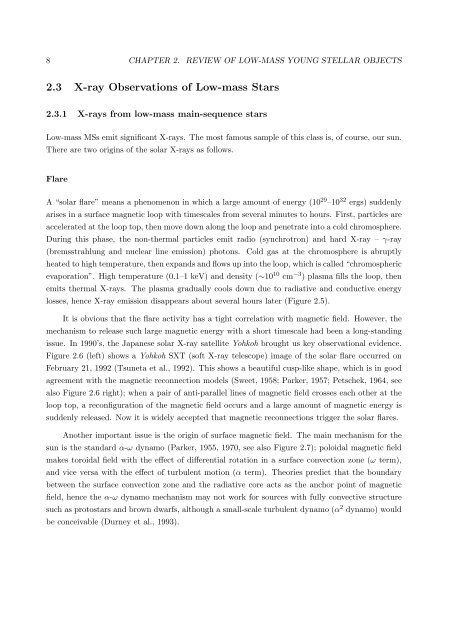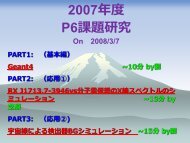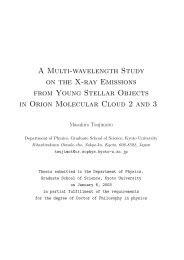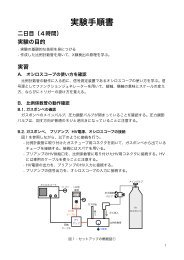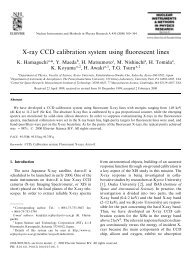X-ray Study of Low-mass Young Stellar Objects in the ρ Ophiuchi ...
X-ray Study of Low-mass Young Stellar Objects in the ρ Ophiuchi ...
X-ray Study of Low-mass Young Stellar Objects in the ρ Ophiuchi ...
Create successful ePaper yourself
Turn your PDF publications into a flip-book with our unique Google optimized e-Paper software.
8 CHAPTER 2. REVIEW OF LOW-MASS YOUNG STELLAR OBJECTS2.3 X-<strong>ray</strong> Observations <strong>of</strong> <strong>Low</strong>-<strong>mass</strong> Stars2.3.1 X-<strong>ray</strong>s from low-<strong>mass</strong> ma<strong>in</strong>-sequence stars<strong>Low</strong>-<strong>mass</strong> MSs emit significant X-<strong>ray</strong>s. The most famous sample <strong>of</strong> this class is, <strong>of</strong> course, our sun.There are two orig<strong>in</strong>s <strong>of</strong> <strong>the</strong> solar X-<strong>ray</strong>s as follows.FlareA “solar flare” means a phenomenon <strong>in</strong> which a large amount <strong>of</strong> energy (10 29 –10 32 ergs) suddenlyarises <strong>in</strong> a surface magnetic loop with timescales from several m<strong>in</strong>utes to hours. First, particles areaccelerated at <strong>the</strong> loop top, <strong>the</strong>n move down along <strong>the</strong> loop and penetrate <strong>in</strong>to a cold chromosphere.Dur<strong>in</strong>g this phase, <strong>the</strong> non-<strong>the</strong>rmal particles emit radio (synchrotron) and hard X-<strong>ray</strong> – γ-<strong>ray</strong>(bremsstrahlung and nuclear l<strong>in</strong>e emission) photons. Cold gas at <strong>the</strong> chromosphere is abruptlyheated to high temperature, <strong>the</strong>n expands and flows up <strong>in</strong>to <strong>the</strong> loop, which is called “chromosphericevaporation”. High temperature (0.1–1 keV) and density (∼10 10 cm −3 ) plasma fills <strong>the</strong> loop, <strong>the</strong>nemits <strong>the</strong>rmal X-<strong>ray</strong>s. The plasma gradually cools down due to radiative and conductive energylosses, hence X-<strong>ray</strong> emission disappears about several hours later (Figure 2.5).It is obvious that <strong>the</strong> flare activity has a tight correlation with magnetic field. However, <strong>the</strong>mechanism to release such large magnetic energy with a short timescale had been a long-stand<strong>in</strong>gissue. In 1990’s, <strong>the</strong> Japanese solar X-<strong>ray</strong> satellite Yohkoh brought us key observational evidence.Figure 2.6 (left) shows a Yohkoh SXT (s<strong>of</strong>t X-<strong>ray</strong> telescope) image <strong>of</strong> <strong>the</strong> solar flare occurred onFebruary 21, 1992 (Tsuneta et al., 1992). This shows a beautiful cusp-like shape, which is <strong>in</strong> goodagreement with <strong>the</strong> magnetic reconnection models (Sweet, 1958; Parker, 1957; Petschek, 1964, seealso Figure 2.6 right); when a pair <strong>of</strong> anti-parallel l<strong>in</strong>es <strong>of</strong> magnetic field crosses each o<strong>the</strong>r at <strong>the</strong>loop top, a reconfiguration <strong>of</strong> <strong>the</strong> magnetic field occurs and a large amount <strong>of</strong> magnetic energy issuddenly released. Now it is widely accepted that magnetic reconnections trigger <strong>the</strong> solar flares.Ano<strong>the</strong>r important issue is <strong>the</strong> orig<strong>in</strong> <strong>of</strong> surface magnetic field. The ma<strong>in</strong> mechanism for <strong>the</strong>sun is <strong>the</strong> standard α-ω dynamo (Parker, 1955, 1970, see also Figure 2.7); poloidal magnetic fieldmakes toroidal field with <strong>the</strong> effect <strong>of</strong> differential rotation <strong>in</strong> a surface convection zone (ω term),and vice versa with <strong>the</strong> effect <strong>of</strong> turbulent motion (α term). Theories predict that <strong>the</strong> boundarybetween <strong>the</strong> surface convection zone and <strong>the</strong> radiative core acts as <strong>the</strong> anchor po<strong>in</strong>t <strong>of</strong> magneticfield, hence <strong>the</strong> α-ω dynamo mechanism may not work for sources with fully convective structuresuch as protostars and brown dwarfs, although a small-scale turbulent dynamo (α 2 dynamo) wouldbe conceivable (Durney et al., 1993).


